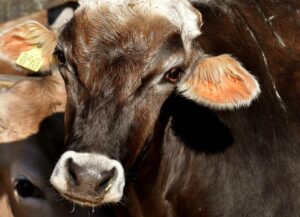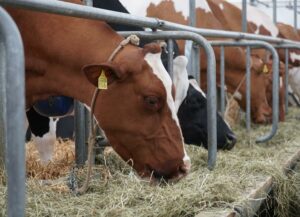Fernando Diaz
Ruminal acidosis results from an excessive acid load in the rumen not neutralized by salivary or feed buffers. Cows susceptible to both subacute (SARA) and acute ruminal acidosis change their metabolism, eating behavior, and production performance. Measuring ruminal pH on commercial dairy farms is impracticable. Thus, developing alternative methods for identifying cows with low pH would help dairy veterinarians and nutritionists managing rumen health.
A recent study published in Journal of Dairy Science determined whether blood metabolite concentrations were associated with ruminal pH in high-producing dairy cows (52 kg milk/day). The researchers (Nasrollahi et al., 2019) fed 78 Holstein cows a TMR consisting of 35% forage and 65% concentrate in a dry matter (DM) basis. Approximately four hours after feeding time, they collected ruminal fluid from the ventral sac by rumenocentesis and blood samples from the tail.
Cows were classified according to their rumenocentesis pH as:
- High ruminal pH: greater than or equal to 6.0 (33.3% cows)
- Medium: pH greater than or equal to 5.8 and lower than 6 (26.9%)
- Low: pH lower than 5.8 (39.7%)
Cows with high ruminal pH showed greater DM intake (26.8 vs. 24.6 and 24.4 kg/day) and body weight (708 vs. 659 and 655 kg) compared with cows with medium and low ruminal pH. Milk yield and milk protein content were similar among groups; however, cows with high ruminal pH had greater milk fat percentage (2.42 vs. 2.12 and 2.10%). In addition, backfat thickness, measured using a portable B-mode ultrasound, of cows with high pH was 2.6 and 3.6 mm greater than cows with medium and low pH, respectively.
The authors reported that cows with low ruminal pH had greater aspartate aminotransferase (AST) activity in blood (70.7 U/L) than cows with medium (59.9 U/L) and high ruminal pH (56.0 U/L). Since this enzyme is produced mainly in the liver, this indicates that ruminal acidosis may cause histological damage in the liver so the level of AST in blood are increased due to changes in the cellular integrity of hepatocytes.
Interestingly, other blood metabolites such as NEFA, BHBA, creatinine, glucose, triglyceride, cholesterol, total protein, globulin, and alkaline phosphates were similar among the different ruminal pH groups.
In conclusion, this study showed that ruminal acidosis affects lactation performance and body reserves, and the concentration of aspartate aminotransferase (AST) activity in blood may be a possible indicator for ruminal acidosis in lactating cows.
Reference
M. Nasrollahi, A. Zali, G. R. Ghorbani, A. Kahyani, and K. A. Beauchemin. 2019. Short communication: Blood metabolites, body reserves, and feed efficiency of high-producing dairy cows that varied in ruminal pH when fed a high-concentrate diet. J. Dairy Sci. 102:672–677.
© 2019 Dairy Knowledge Center, LLC. All Rights Reserved.









